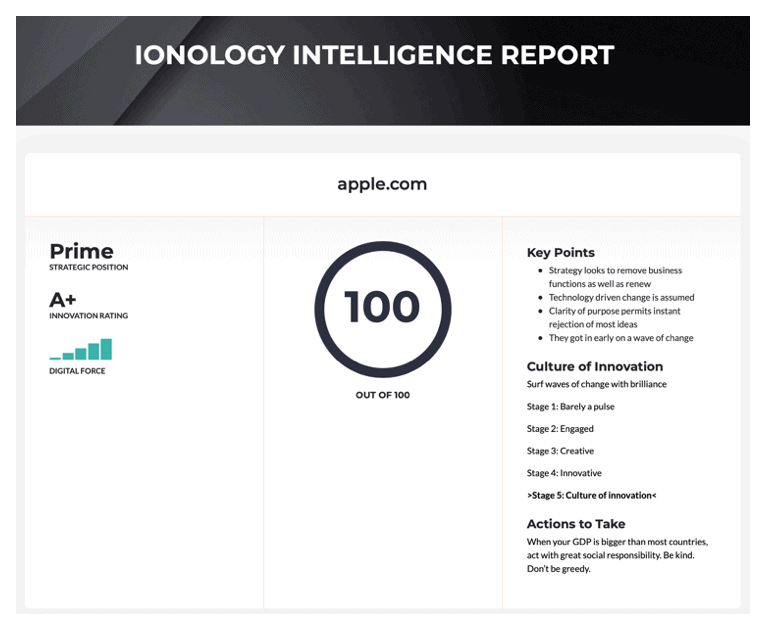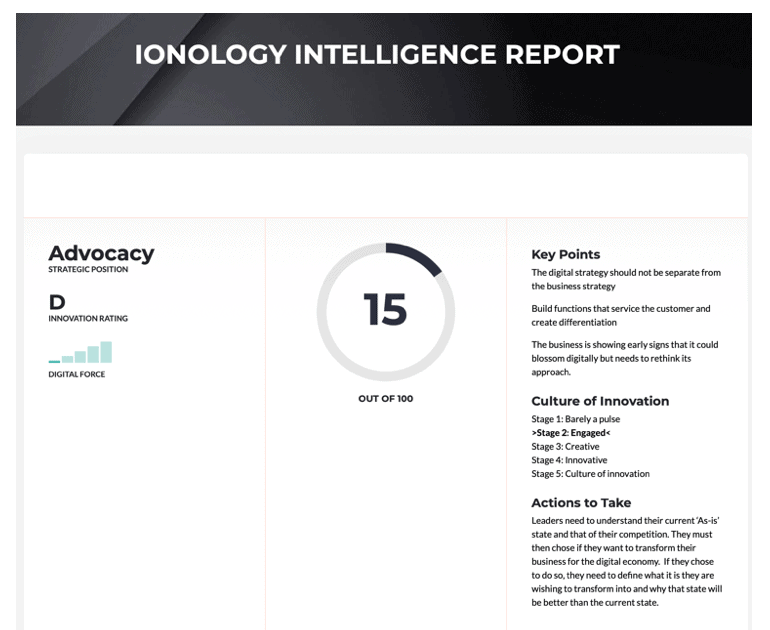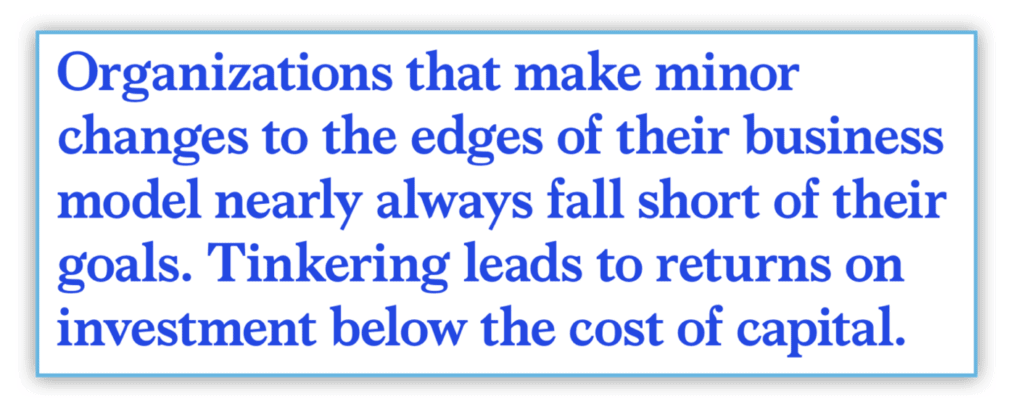What is Digital Transformation?
Digital transformation is the deliberate, strategic, repositioning of one’s business in the digital economy. The word “Digital” is a synonym for the pace of change that is happening in today’s world, driven by the rapid adoption of technology. “Transformation” in this context, is how an organisation is built to change, innovate and reinvent rather than simply enhance and support the traditional methods.
Transformation takes place when we innovate – creating new products, services and business models. These new innovations are favoured by the customer and have an impact on our industry.
As an example, implementing a new online ticketing support system for customers. This isn’t transformational. This is a digitised service that is replacing the manual service but it’s not innovative. It’s simply matching customer expectations.
Now imagine what would happen if we removed the need for the support query entirely because an AI bot spotted and fixed the problem before it happened. That’s an innovative game changer. This solution would change the business, impact the industry and delight customers. It would also create new competitive advantage. Imagine changing the business model so the customer no longer pays when things break rather, they pay for continuous non-interrupted service. Guaranteed uptime rather than rapid response to downtime. That’s a business model innovation. That’s digital transformation.
 To deliver such a solution requires a radical overhaul of product development, the support team, investment in innovation, communications, sales, finance and more.
To deliver such a solution requires a radical overhaul of product development, the support team, investment in innovation, communications, sales, finance and more.
Digital Transformation isn’t a side project. It’s not a strategy among many strategies. It is THE strategy by which all other plans sit. It is an attempt to reposition a business within the digital economy. It’s not just a job for IT. Few IT leaders have the consent, authority, training or diplomacy to transform a business.
It’s first and foremost a leadership challenge. If leaders neglect to gain digital transformation education they will struggle to understand the business capability of emerging technology, data and modern frameworks for strategic planning. The result is that the business will simply digitise. This leaves it vulnerable to disruption.
Digital Transformation versus Digitisation, Explained
The term ‘digital’ is often applied to any new technology, the word ‘transformation’ is more ambiguous. The reason is that technology alone does not transform a business. Leadership, mindset, strategy, culture, communications, innovation and data are often more important than the technology itself, if we really want to transform.
Digitisation is most often mistaken for transformation. The process of taking existing processes and digitising it is an important first step. It’s not, however transformational. We’ve been using technology to improve existing physical and intellectual processes since the industrial revolution. Customers expect businesses to have websites, apps and social channels and platforms. That does not transform a business. It gives them permission to continue to serve their customer base.
According to Harvard Prof. Michael Porter, producing greater operational efficiency [using technology] is something that should be done but it’s not strategic. Digital transformation is the strategic repositioning of one’s business in the digital economy.
Digital Transformation Examples
|
|
||
| 1. Non-technical decision makers within the business understand the power of data-driven-decision making. They have taken digital transformation course on the business capabilities of emerging technology | 1 Technical people are told to transform the business but are only given permission to perform technical upgrades. Leaders dismiss the idea that they need to be involved in digital transformation. | ||
| 2. The digital transformation strategy is built by the business unit to change what they business does to enhance competitive advantage and improve customer experience | 2. The strategy is created by IT to introduce new technology into the business and create internal efficiency | ||
| 3. Communications professionals seek to measure and reposition the business in the minds-eye of the customer by creating a new value proposition that attracts more customers and creates enthusiasm for change, internally. | 3. Building websites, social channels and performing digital marketing is necessary but not transformational | ||
| 4. The business has a set process for innovation (regardless of size). The innovations are used to answer ‘unknowns’ that are highlighted within the strategy. Often solutions require collaborations between parties of loosely connected groups in-side and outside of the business | 4. Good ideas and creativity is mistaken as Innovation. Innovation requires process, practice, resource and strategic application. Without this, it’s just random acts of digital. | ||
| 5. Technology is frequently researched as to how it can be leveraged to create new and exciting ways of working, adding greater value to the customer and creating additional competitive advantage | 5. Technology is seen as a necessary tool to make the business work. It’s seen as the domain of IT and is implemented sporadically and only in proven outcomes. | ||
| 6. Data is leveraged to create new products, services and business models. Predictive models and machine learning are used to create a more differentiated business |
|
The Ionology 5 Change Blocks of Digital Transformation
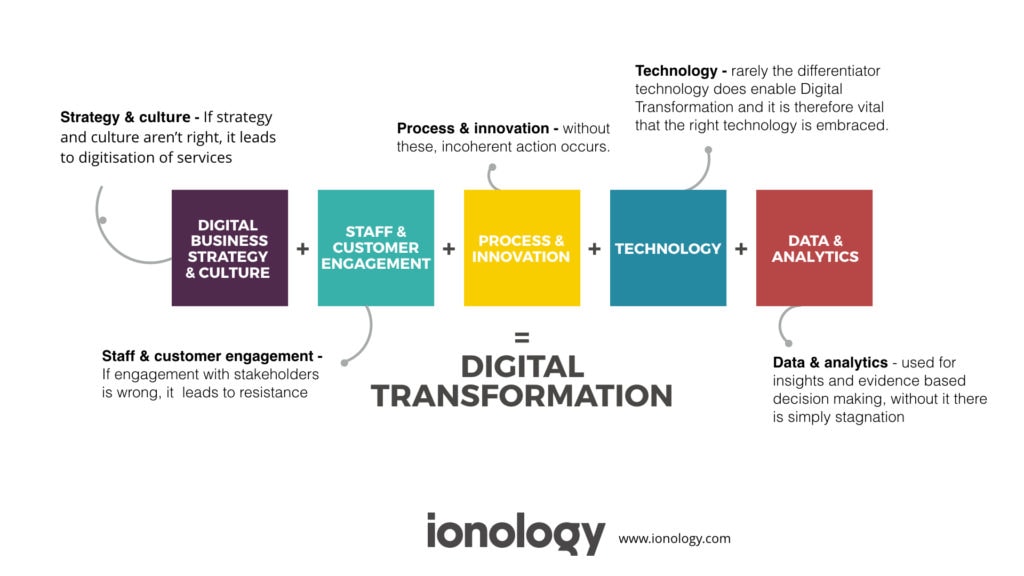
5 Change Blocks of Digital Transformation
The 5 Most Important Skills Required for Digital Transformation Leaders
Transforming a business so it performs better in the digital economy is not an easy task. It requires a good mix of innovation, leadership, communications, technology and vision. It’s as much a political game as a technical one. Some will resist the change, others will embrace it. One thing is for certain is that the current business silos won’t answer new customer requirements.
In government, legislation change is often needed to remove barriers that prevent true government transformation. In the corporate sector, innovation can run across multiple divisions, partnerships and even will often require the forging of new alliances. This is not the natural domain skillset of technologists. Diplomacy, vision, changed operating and business models means that digital transformation requires a broad set of skills.
Here’s our take on the 5 most important skills required for digital transformation leaders.
1. Define the meaning of digital transformation, what’s the objective, the permissible risk, desired innovation and why the transformed state is better than the existing state
A good leader uses data and digital transformation frameworks to identify the opportunities for innovation and differentiation. They understand the difference between digitization and transformation.
2. Ability to call out the nonsense and dismiss corporate mythology
“We cannot because…” is the most invoked slogan for slowing transformation. Policy, regulation, customer behaviours or lack of authority are cited as the top reasons. Yet when we ask to see the page in the regulations or policy that specifically states; “we cannot.”, it never exists. Customer acceptance of change is rarely tested and authority never challenged – it needs to be!
3. To write, test and prove/disprove hypothesis, quickly
There’s a difference between a plan to maintain business as usual and business transformation. The former is an operational plan (not a strategy) and the latter is a strategic repositioning. With this repositioning comes many unknowns. They need clear definition and deep thinking, clear guidance and designed experiments to test leap of faith assumptions. Without this kind of thinking and planning, we get random acts of digital.
4. To stay strategic while all around you are drowning in tactics
A proliferation of digital tactics is a result of poor leadership and weak strategy. If you can’t articulate the destination (the ‘to-be’ state) and maintain lazer focus on data driven outcomes the result will be a sea of uncoordinated digital activity with the sum of the part failing to show a return on capital.
5. Filter the data signals from the noise and subsequently pursue meaning and truth
A small business gets over 1,000,000 impressions on natural search in Google. It gains 20,000 website visits and practically no sales leads. The owner blames the digital marketing agency. The reality is that their business isn’t fit to compete in the digital economy. A data aware leader can see these signals and transform accordingly.
The biggest throttle on the pace of transformation is typically a lack of understanding of the role of leadership. While they may grant budget and resources, they often fail to upgrade their own thinking. Domain expertise is vital for digital transformation but so too is understanding data. Creating a digital transformation strategy is not something that can be outsourced to IT. Leaders, managers and decision makers must take a course in leading digital transformation if they are stay relevant in creating a transformed business.
So how do I convince my leader that we need to digitally transform??…
5 Steps to Convince Your Leaders to Digitally Transform
The best way to convince business leaders of the need to transform is to show them data. It removes the need for finger pointing and blame and provides a great narrative for why change would help. Most leaders, when confronted with data in context with their business, will listen to the argument. The best reasons for transformation should not be technical. Keep the conversations about the data and relate it to business opportunity, changing customer expectations and explain the journey of transformation.
1. Explain the what digital transformation is and why it’s important. Start with a high-level model like the Digital Transformation Actions/Outcomes model and ask them where they think the business sits. This activity provides great opening perspective and lively discussion.
Digital Transformation Maturity Model
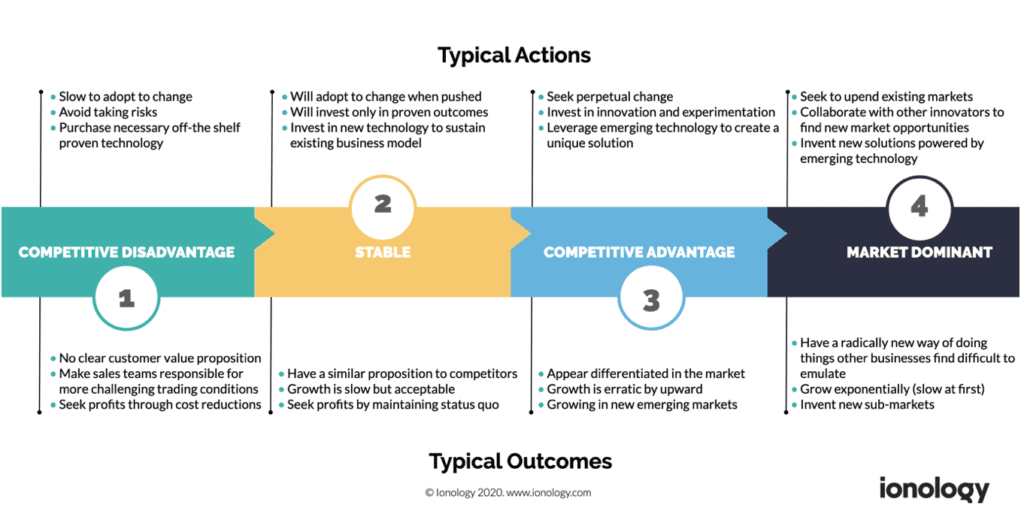
To note – most businesses are at stage 1 or 2. Transformation starts to take place as we bridge from 2 to 3. While many businesses may have glimmers of stage 3, unless the core of the business is practicing the actions of a stage 3 business it’s wise to consider the business as a stage 2 with stage 3 tendencies!
2. Use Propulsion to measure your business’s likely effectiveness in the digital economy when compared to competitors.This tool scores the digital footprint of a business against its peers. It is not an analysis of digital marketing and it doesn’t analyse website content. What it does look for are the signatures of innovation and compares that with other successful digital businesses.
Digitally transformed businesses innovate and publish. As a result of their success they shape their niche. This innovation is in turn rewarded by customers and industry insiders citing the innovation with positive sentiment. The greater the digitally activity and successful a business is in the digital economy, the higher their Propulsion score.
The big global innovators score 100
Undifferentiated businesses score much lower
3. Use free, publicity accessible data such as Google Keyword Planner to understand market demands. Keyword Planner is designed to help marketers understand demand. It is also an amazing tool in helping to understand what customers are looking for, the language they use and if demand for your product or service is rising or falling.
This is an Ionology case study in which we demonstrate how the data tools are used, in context with other data platforms, to help create a data-powered narrative.
It is advisable to seek a digital transformation course to help with this exercise.
4. Build a business story, not a technology wish-list. Use a digital transformation framework to give the data context. Build a story of what can happen. The framework will provide structure and create data points which will offer credible and coherent information that Leaders will expect in order to make informed decisions when deciding on next steps.
5. Start with executive education for the entire company – gain the digital mindset. In our experience, if the leaders don’t gain the digital mindset through education – digital transformation will fail. This is also true for the wider organisation. Anyone who’s role is affected by digital transformation should take a short programme of education (generally 1 – 2 days). If employees are not aligned and do not understand their role within the wider digital transformation strategy – you will experience resistance. This collective resistance can prove to be a dominant obstacle in the face of digital transformation.
Top 10 Reasons Why Digital Transformation Fails (and how to avoid it)
1. You Are Under-committed To Digital Transformation
In a 2020 MITSloan Management Review, Scott Anthony and Michael Putz wrote:
“The default positions, it seems, are to squeeze extra points from profit margins, search for companies to acquire, or simply pay lip service to innovation by setting up token incubators or having executives wear jeans and the occasional hoodie.”
The article argues that we know the causes of disruption but we are so focused on short-term profits that we only pay lip service to truly transforming our business through deliberate acts of innovation. Having an innovation process is pointless unless it’s leveraged to transform the business continuously.
Having a technology division that is ‘agile’ is useless unless the leadership is agile, teams are agile and the culture of risk is embraced and controlled. Constant learning, at scale, is the new management requirement.
In Bill Gates’ book, The Road Ahead, he discusses the evolution of personal computing: “We always overestimate the change that will occur in the next two years and underestimate the change that will occur in the next ten. Don’t let yourself be lulled into inaction.” As a result many businesses get disillusioned with a lack of customer take-up and visible immediate return on investment when it comes to technology focused innovation and change.
In the 2018 Gartner Hype Cycle, they cite Artificial Intelligence as coming of age in 2-5 years. We are now heading for 2021 and right on cue AI is heading into the Trough of Disillusionment, meaning that it isn’t making the headlines as it once did. It gives the appearance of disappearing as the media hype dies but in reality it’s quietly preparing itself to steel thousands of jobs.

Source: Gartner
In February 2020, Microsoft heralded “largest language model ever published at 17 billion parameters.”. In May 2020, OpenAI, a for-profit San Francisco-based artificial intelligence research laboratory launched GPT-3 with 175 billion machine learning parameters. The potential impact of this technology is mesmerising.
The Turing Test is devised to see if a human can tell if they are talking to a computer or a robot. AI often struggles with common sense. That struggle is rapidly ending and human/computer conversations are about to go way beyond the primitive Alexa we all know and love now.
This is an example of GPT-3 in action at Lacker.io

Here is an example of how GPT-3 can create infinite ideas:
 Source: https://twitter.com/PaulYacoubian
Source: https://twitter.com/PaulYacoubian
This is infrastructure waiting for an application. The applications will come and they will come soon. We’re at a moment in the Information Age where platforms manifest in the blink of an eye, automating jobs, functions and cognitive heavy-work. The applications will automate jobs that we believe are beyond automation. Creativity that we thought wasn’t replicable by technology. And while AI may not immediately replace leaders, leaders that understand AI will replace those that don’t. By the time disruption comes knocking, it’s often too late to change the business. This is because the business isn’t built to change. It’s built to maximise opportunity and profit today and reward adherence and compliance.
The solution is that leaders should understand the business capabilities of AI and other emerging technologies and seek to use them in a strategic way to change the business. Leaders need to commit, bringing a committed organisation with them as they do.
2. Politics Hindering Digital Transformation
John Hagel has spent 40 years in Silicon Valley. An experienced management consultant, author and owner of Beyond Our Edge, he helps executives to anticipate and address emerging business opportunities and challenges.
“We are talking about changing almost everything in most companies, that’s transformation. And the question is, how do that?” – Hagel asks in the SingularityU summit in Bangkok.
“I will say that I’ve been involved in transformation activities for several decades and I really only have one lesson to share with you from all that experience. And that lesson is that if you believe that transformation is a rational process. If you believe that it is about getting the right data, the right analytics, putting it on the right charts, presenting it to the right people, you’ve already lost!”
“In my experience, transformation is not a rational process. It is fundamentally a political process.”
People are fundamentally not afraid of change, they are afraid of the unknown. Many people define their lives by their job. The number of direct reports, the status and respect that brings. If threatened, they will find ways to create inertia and slow transformation unless the outcomes for them are clear.
Technology doesn’t transform a business. People do, leveraging technology. And with people comes politics. To avoid the political uncertainty, education and a clearly articulated strategy and vision goes a long way. Even if the strategy is full of ‘unknowns’, helping teams identify and solve these gaps is a powerful collaborative motivator. A strategy where people see their new function and understand why it is better than the current. Without this, the pace of change will be hampered and even stopped.
3. ‘Fragility’
“I’d rather be dumb and antifragile then extremely smart and fragile” – This is a quote from Nassim Taleb and is book Antifragile – Things that gain from disorder.
Taleb is a celebrated scholar, mathematical statistician, and former option trader and risk analyst, whose work concerns problems of randomness, probability, and uncertainty.
Taleb introduces his book Antifragile as follows: “Some things benefit from shocks; they thrive and grow when exposed to volatility, randomness, disorder, and stressors and love adventure, risk, and uncertainty. Yet, in spite of the ubiquity of the phenomenon, there is no word for the exact opposite of fragile. Let us call it antifragile.
“The antifragile loves randomness and uncertainty which also means, crucially a love of errors. A certain class of errors. Antifrigility has a singular property of allowing us to deal with the unknown. To do things without understanding them and doing them well.”, says Taleb.
The best way to understand what it means to be Antifragile is to consider how exercise stresses a muscle and as a result the muscle grows stronger. Or how, when a protest is suppressed it often grows in mass.
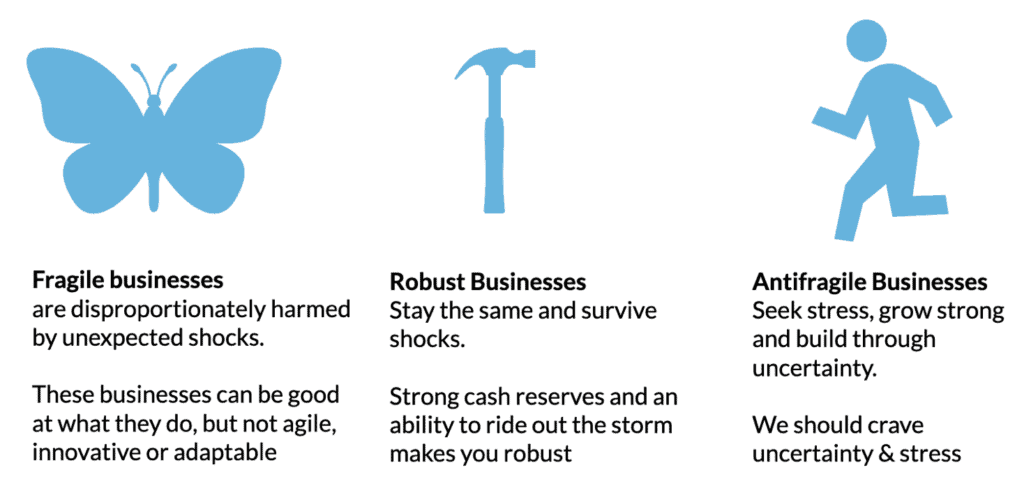
Which of these best describes your business?
Fragile businesses are harmed by shock. Examples of shock could be Covid-19, a stock market crash, a disruption in the marketplace or technology induced change. These businesses are built on rigid processes and are the hardest to transform. It requires that leaders, managers and decision makers educate themselves on what it means to have the ‘digital mindset’ and how to innovate leveraging emerging tech.
This all ties in very closely with John Hagel’s advice to build a business that is in constant search for new things to learn. What he refers to as Scalable Learning over Scalable Efficiency.
4. Faster ≠ Transformation
Two banks go head-to-head to grow and win more customers. They both have similar interest rates and offer similar business and consumer services.
| Service | Bank A | Bank B |
|---|---|---|
| Open an account | 3 weeks | 1 day |
| Personal Loan Approval | 5 days | 1 day |
| Card replacement | 5 days | 2 days |
| Mortgage approval | 2 weeks | 2 days |
Bank B clearly had the upper hand as market-share statistics showed. Bank A was losing customers to Bank B at a rate of 7% per year. Bank A was growing rapidly as it acquired new unbanked customers and the attrition from Bank A.
Bank A decided to digitally transform. To upgrade its services it invested in a new core banking system and overhauled its business processes. At the end of the technology upgrade, Bank A was, by and large, faster than Bank B.
| Service | Bank A | Bank B |
|---|---|---|
| Open an account | 1 week | 1 day |
| Personal Loan Approval | 4 hours | 1 day |
| Card replacement | 1 day | 2 days |
| Mortgage approval | 4 hours | 2 days |
The impact on Bank A was immediate and obvious. They stopped losing customers. Their expectation, however, was that customers would come flooding back. That new emerging unbanked customers would select them. That didn’t happen. All they managed was to stop customers leaving for Bank B. They didn’t manage to reposition the bank in the minds-eye of the customer.
This kind of activity is foretold in innovation theory and had the leadership of Bank A understood the theory they would have seen that the technology upgrade was essential but still not enough for the turnaround of the bank.
Professor Clay Christiansen explained in his book The Innovators Dilemma that there is a tolerance point for new, bells, whistles and functions on existing product or service lines.
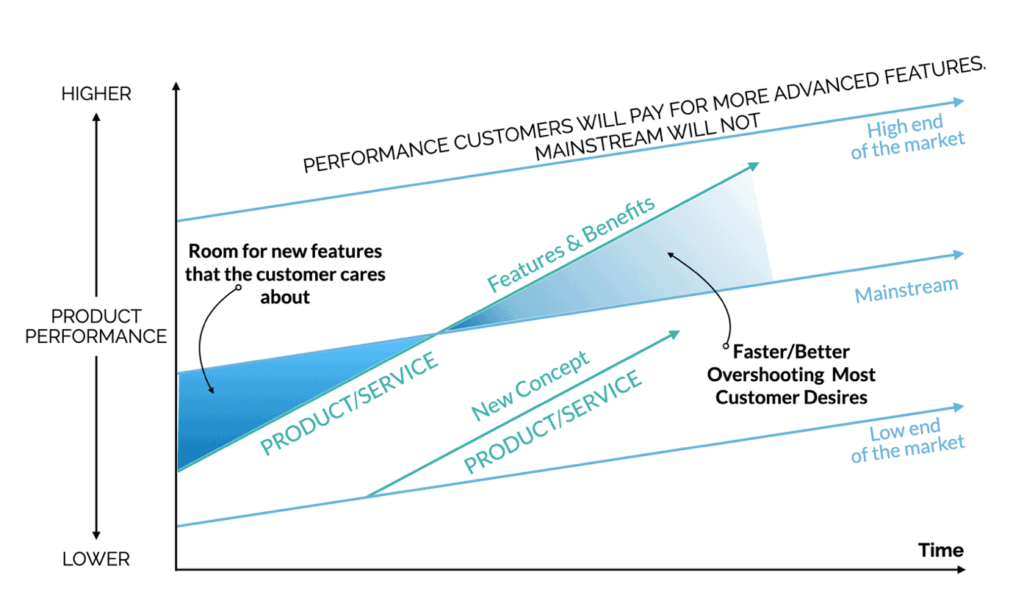
Christiansen argues that once the mainstream market needs are met, going bigger and faster has diminishing returns. That innovation requires finding something new that the customer cares about. This won’t happen without deliberate practice. The answer is rarely obvious. In the absence of taking risks many businesses copy competitors and feel that building a faster or upgraded version of what exists will excite the customer and create competitive advantage. This is rarely the case and it also assumes the competitor won’t innovate faster and in new directions.
5. Be Careful of Bias
Experiments have found repeatedly that people tend to test hypotheses in a one-sided way, by searching for evidence consistent with their current hypothesis.
We are designed to believe what we want to believe. Our brains push us to grab information we see. This is called priming. And that impacts how we see subsequent data. This is called framing. Once we come to believe something we look for information that confirms it. This is known as Confirmation Bias.
A person may cherry-pick empirical data that supports one’s belief, ignoring the remainder of the data that is not supportive. People also tend to interpret ambiguous evidence as supporting their existing position. The effect is strongest for desired outcomes, for emotionally charged issues, and for deeply entrenched beliefs.
Ask a sales guy what the customer wants – they’ll tell you, “The customer wants more sales guys”. But this is so obviously biased yet the sales guy says it with such conviction. It’s not that their job was under threat, it’s that they truly believe that they help the customer more than automation. It turns out that the customer prefers a good self-service model. But the data for keeping the sales guys doing the same job year in and year out, could have been be cherrypicked and framed.
Most transformation projects fall short because unintentional confirmation bias supports the existing way of doing things. It takes training and expertise to be truly sceptical and question evidence with an open mind. It’s so much easier to support what we know rather than face the daunting truth that lies hidden in data.
How do I avoid this pitfall? Empower yourself with education and discover how to leverage data (without bias) for your organisation.
6. The War of Ideas
The war of ideas goes on in business today. Ask ten executives what digital transformation means to them and you’ll get a broad variety of answers. Many think it’s the upgrading of technology to create operational efficiency. Others think it’s something to do with innovation. A third cohort will say that it’s got something to do with repositioning the business while a forth connect the term with digital marketing.
Unspoken disagreement among top managers about the goals of digital transformation is a common killer.
The starting points are to agree:
- What is digital transformation? – define what the term is and what its’ not. Upgrading IT happens every year. Don’t delude the business by saying it’s suddenly “transformative”.
- What the ‘to-be’ state looks like
- Why that ‘to-be’ state is better for everyone including staff and customers
- How we plan to get there.
Using digital transformation frameworks and data-driven decision making will increase the likelihood of remaining focused on the business challenge and ability to set outcome based objectives.
7. Ambition is Greater Than Resource
Antok Medical Insurance wants to change their industry. They plan to innovate at scale and change the perception of what it means for patients to have medical insurance. They’ve formed a small team to specify and build a pilot. They have validated their ideas with customers and a third party consultancy firm. All looks good on paper and the leadership team feel certain of success.
The problem is that the businesses internal systems won’t support rapid deployment of new innovations. Their data privacy policies won’t permit the use of previous insurance claims to be used in the creation of new predictive models. The business doesn’t have the skills needed in-house to create the technology required and even if they did, there is simply no way the business could scale. The management teams don’t have the time, capacity or capability to merge the new platform while running their existing business.
There are three phases of transformation to consider:
- Without having first digitised, it’s difficult to transform.
- Without having the right infrastructure, it’s impossible to build upon
- Without the right mindset and education throughout the organisation it’s impossible to scale.
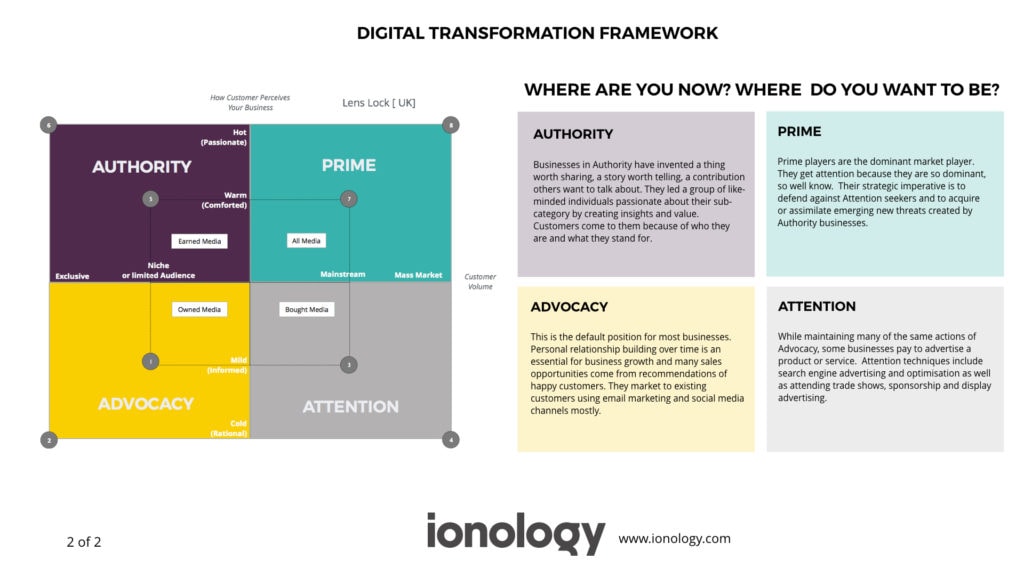
Ionology Digital Transformation Framework
Antok needs to either lower their ambition or invest substantially more time and cash than they had ever thought they’d need. Should they do so and their plan work, they will change their industry and with it will reap the rewards. It’s a risky business, but then again, insurance is literally a risk-based business!
8. People are not the key to success. Digitally educated people are!
April 2020 and the world was in lockdown. McKinsey Digital released their white-paper entitled “Digital Strategy in a Time of Crisis”.
Scroll down from the title in this article and a full page emphasises the key message of the report: “Now is the time for learning at scale”.
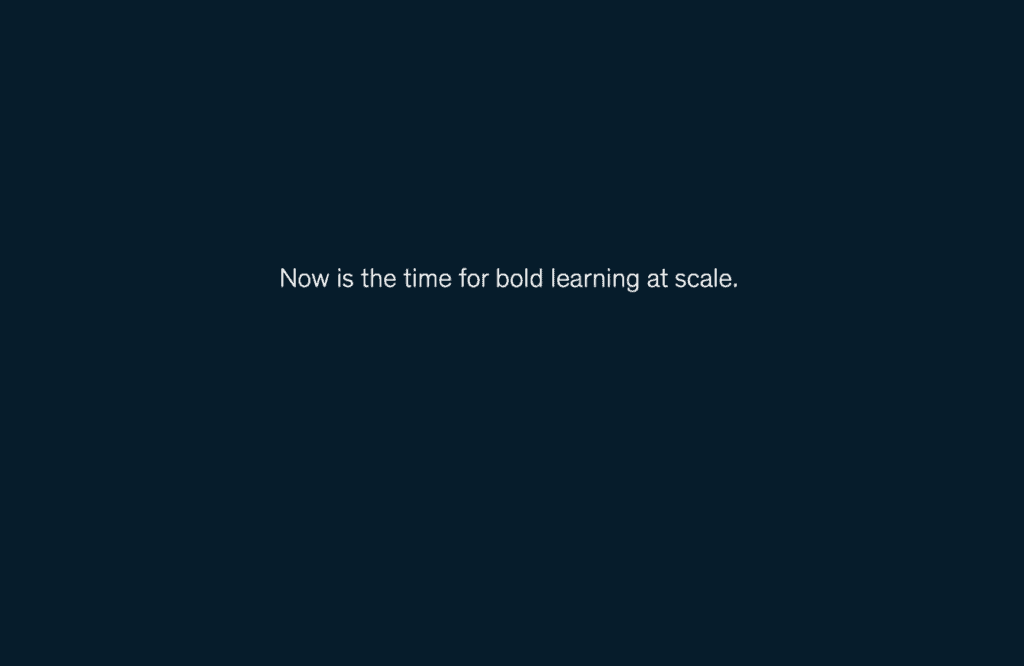
The full page message to emphasise the point
This isn’t a call to action for the lockdown. It’s saying that a small team of digital adventurers embedded in a business just isn’t going to cut it in the post-covid world. That all businesses, at all levels, need to rethink their internal capabilities.
Technology doesn’t transform a business.
People don’t transform a business.
Digitally educated people, leveraging emerging technology, transform a business.
Digitally educated people are the missing element for scaling digital innovation in most businesses.
Leaders, managers, non-technical decision makers and subject matter experts all need to understand the power of data, the business value of emerging technology and how to strategically leverage through deliberate practice.
Building a Digital Academy that addresses leadership and strategic thinking as well as operational and practical roll out is fast becoming the new normal in mid-large enterprises.
The wrong way to roll it out is to insist that everyone fits in online courses in-between their day job and takes an online course. This has very limited success. Much more effective are collaborative workshops designed to solve real business problems. Learning-by-doing builds teamwork, peer learning and inspires forward momentum.
The report highlights “Organisations that make minor changes to the edges of their business model nearly always fall short of their goals. Tinkering leads to returns on investment below the cost of capital.”
Under-committing and under resources leads to tinkering. Tinkering leads to a death spiral in the transformation process. It’s when new, more sophisticated competitors emerge that the reprisals start and by then, it’s too late.
9. The Digital Transformation Technology Fallacy
Leading schools of thought…
- “Strategy, Not Technology, Drives Digital Transformation” – Deloitte.
- “Digital Transformation Is Not About Technology” – Harvard Business Review
- “The Technology Fallacy – How People Are the Real Key to Digital Transformation” – MIT
The Ionology school of thought…
To dismiss technology as a tool is myopic in my opinion. Technology isn’t just a tool, a means to an end, it can also inspire us to do things differently.
The authors are perfectly correct, however, to illustrate that technology is only one component when modernising a business through digital transformation. In most transformations, the technology is well resourced and the technologists deliver. The greatest inertia comes from people.
People are defined by their jobs. You can be a Doctor, Nurse, an Electrician or even something more nebulous like a TicTok(er). To change a job role is to pull at the fabric of who you are. Yet most businesses invest way more in the technology than the people. People are expected to comply, to flex, to transform by osmosis. It’s not natural.
While technology is a tool, it’s also a great inspiration. This is put perfectly by the sadly missed Ken Robinson. He puts it beautifully when he says:
“Technology is an instrument. A cupboard full of instruments doesn’t make music. Music comes from the minds of the artist and the instruction of the composer and conductor”.
How to Build a Culture of Innovation – Ken Robinson
Many leaders believe that they are great composers and conductors. What they don’t realise is that how music is created has radically changed in the past 10 years.
Robinson points out that while creativity is needed to maximise the potential of technology and creativity is innate, it requires practice. An artist becomes a great artist by practice. The same is true when innovating, leveraging technology. Innovation takes practice and it’s a human endeavour. In most companies few are given the capacity or teaching in how to innovate at pace.
A problem most businesses face is that those that set the business strategy don’t understand the business capabilities of these emerging technologies. They don’t take the time to ’sharpen the saw’ as Stephen Covey would put it in The 7 Habits of Highly Effective People. Often too busy with their subject matter expertise, they are often given access to an all you can eat buffet of online courses. Yet they don’t have the capacity to study, practice and change their ways. They have been force fed an overwhelming diet of operational duties. Urgent issues always drowning out the more important longer term needs of the business and self-enhancement.
To solve the challenge they look at digital transformation and outsource it to the technologists. The technologists have neither the training or authority to transform the business.
The real solution is to invest in education in digital transformation. The executive board of directors cannot demand business transformation but spend no time transforming themselves. As the Deloitte articles says, Strategy, Not Technology Drives Digital Transformation and strategy is the domain of the business leadership. Digital communications, digital innovation, data and emerging technology can help formulate a modern strategy. To not understand any of these disciplines is to misunderstand what it means to be a modern leader.
While it is a fallacy to think that digital transformation is all about the tech, it’s equally a fallacy to think it can be done by leading the same way as we did in the past.
10. We Digitise and Mistake it as Transformational
Hermann Müller runs a European flower distribution centre outside of Hamburg, Germany. Flowers are sold in bulk; they come in wraps or boxes. The number of stems in a wrap depends on the variety. Foliage is sold by the bunch, smaller plants are sold by the tray, and large items like trees or vases can be sold individually. It’s a complex mix of SKUs that change seasonally.
Over the years Hermann has kept pace with digital technology. His sales team handle most of the orders. His logistics team manage the delivery and his horticulture team, the inventory. He has centralised computing systems and everyone is armed with iPads and can work remotely. When asked if his business has digitally transformed, he proudly suggests that it has.
Unlike Hermann’s orchids, his business is stubbornly refusing to grow. He has sought to minimise overhead by use of technology. What he has noticed is that technology has commoditised his market as other vendors digitise at the same rate. Their inventory is online and its super easy for buyers to see who has what stock. This is driving down prices. Quality of supply and product is simply assumed. Hermann claims his product is the best but even the most discerning buyer will say that their customers can’t really tell the difference in product quality between the suppliers.
Hermann has not digitally transformed. He has simply digitised. Digitising is an important first step on the transformation journey. He was lead to believe that more technology would reduce complexity and add competitive advantage. The opposite happened.
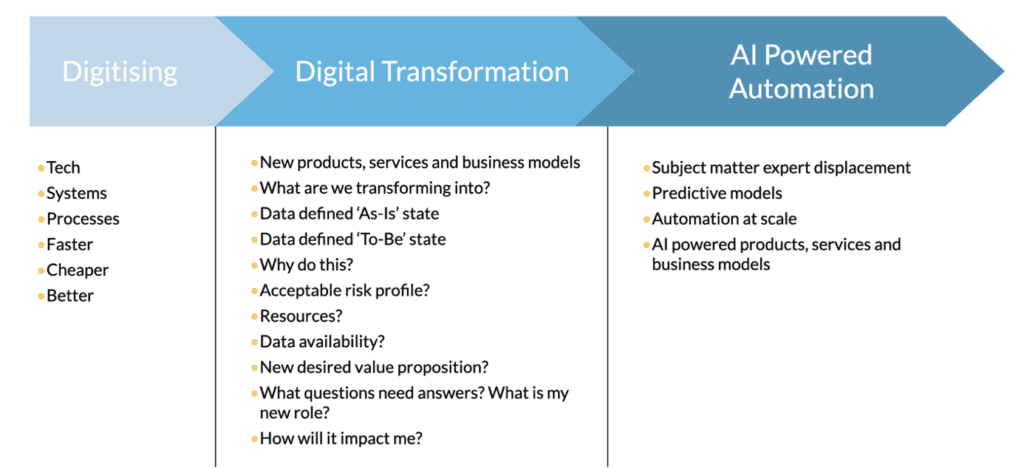
Digital Transformation Journey
His role as the business leader is to find a new method creating new sustaining competitive advantage leveraging emerging technology. He personally has to educate himself in how new business models could work for him. He has to spend time seeking new data driven insights. His role is to lay out a sequence of challenges that he doesn’t yet know the answer to in order to innovate. Then he needs to create the capacity to test those ideas. Finally, he has to create the educated workforce that understand the need and how to scale the innovations within his business.
Most businesses get trapped in digitising their existing business model. They are rightly proud of their accomplishments. What they miss is that this is the starting point, not the end. Hermann knows that he needs to wake up and metaphorically smell the roses. His starting point is to answer the question: understand what is digital transformation? His second challenge is to educate both himself and his leadership team on how best to transform his business through digital innovation.
At Ionology, we have a breadth of experience helping organisations at all stages of the digital transformation journey. We offer education, advisory and consultancy services in leading digital transformation, innovation, data driven decision making and how to leverage emerging technology. If you’d like to find out more as to how we could help you – please give us a call or contact us via email where we’d be happy to advise on how we can be of assistance.
